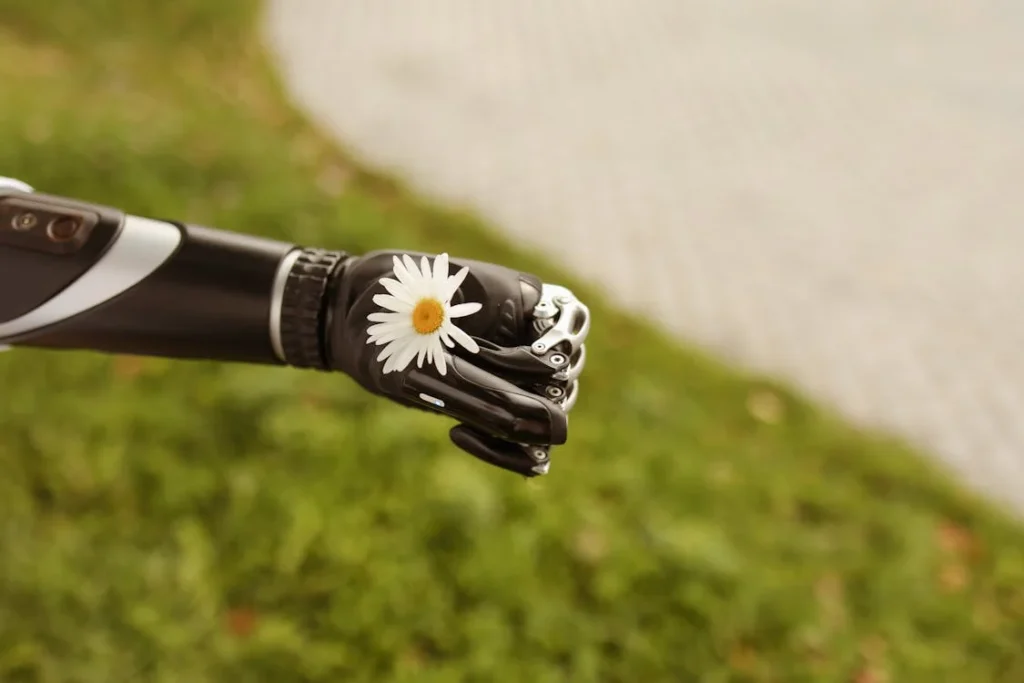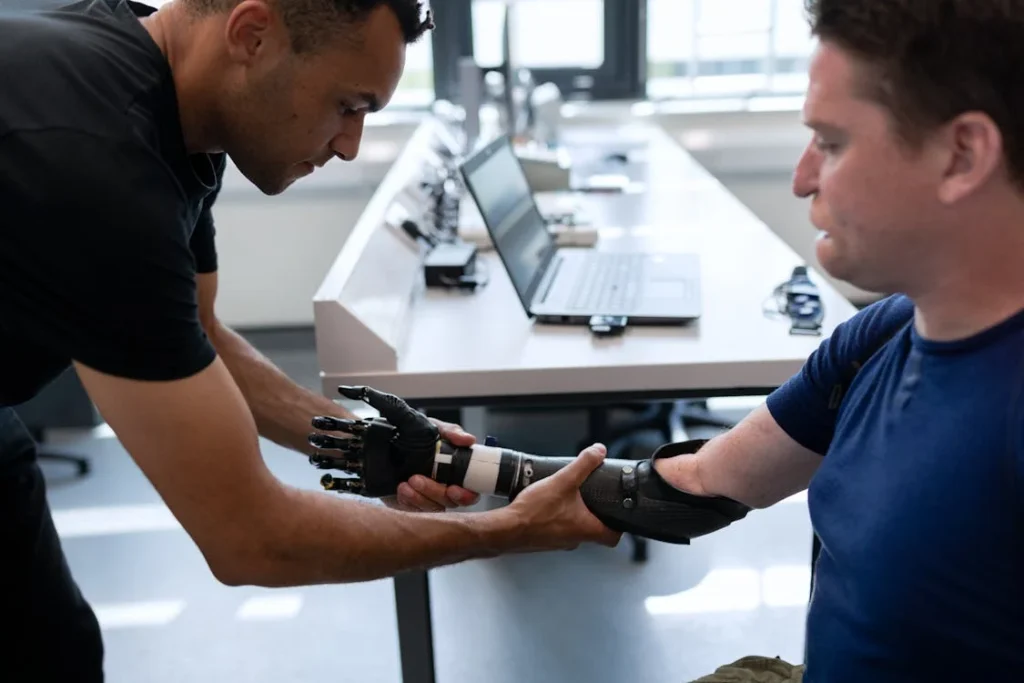Losing a hand changes daily life in many ways, making simple tasks like holding a cup or tying shoelaces difficult. Thankfully, modern prosthetics give people a second chance at independence. But when choosing a prosthetic hand, there are two main types: bionic hands and mechanical hands.
Both have their strengths, but which one truly offers better functionality? The answer depends on many factors, including personal needs, lifestyle, and budget. In this article, we’ll explore the differences, advantages, and real-world impact of both types of prosthetic hands to help you make an informed choice.

What Is a Mechanical Hand?
A mechanical hand is a prosthetic that works without electronic components. It relies on body movement, cables, or external forces to function.
Some mechanical hands open and close using a harness system, while others allow basic grip patterns through simple mechanical structures.
Mechanical hands have been around for a long time and continue to be popular because they are durable, lightweight, and affordable. Many users appreciate their simplicity since they don’t need batteries or electronics, reducing maintenance concerns.
How Does a Mechanical Hand Work?
Most mechanical hands operate through a body-powered system. A person typically wears a harness around the shoulder, which connects to a cable.
Moving the shoulder or upper arm tightens the cable, making the hand open or close. Some advanced mechanical designs use locking mechanisms that allow users to hold objects with less effort.
Another type is the passive mechanical hand, which does not move on its own but helps with stability and support. This type is useful for tasks like carrying bags or steadying objects.

What Is a Bionic Hand?
A bionic hand is an advanced prosthetic that mimics natural hand movements using electronic sensors and motors. Unlike mechanical hands, which require physical effort to operate, bionic hands respond to muscle signals.
Modern bionic hands, like Grippy™ by Robobionics, offer multiple grip patterns, improved dexterity, and even a sense of touch. They use rechargeable batteries and microprocessors to provide smoother and more natural movement.
How Does a Bionic Hand Work?
Bionic hands use myoelectric technology, meaning they detect electrical signals from muscles in the residual limb. When a user thinks about opening or closing their hand, the sensors pick up these signals and activate the motors inside the hand.
Some advanced bionic hands also offer haptic feedback, allowing users to feel pressure or texture to some extent. This technology makes daily activities feel more intuitive, reducing frustration when handling delicate objects.

Comparing Functionality: Bionic Hands vs. Mechanical Hands
When choosing between a bionic hand and a mechanical hand, functionality is often the biggest factor. The way each type of prosthetic performs in real-life situations can make a huge difference in a user’s independence and confidence.
To understand which option is better, it’s important to compare how they handle essential tasks like gripping, movement control, and adaptability to different situations.
Grip Strength and Versatility
One of the biggest differences between bionic and mechanical hands is the way they grip objects. A mechanical hand typically has a simple open-and-close motion, which limits the variety of grips it can achieve.
Some models allow users to adjust the grip slightly, but they often require extra effort or manual adjustments. This makes holding objects like a coffee cup, a pen, or a smartphone challenging, especially if they are fragile or need precise handling.
Bionic hands, on the other hand, offer multiple grip patterns that make everyday tasks easier. With advanced motorized control, users can switch between different grips suited for specific actions.
A bionic hand can hold a key between the fingers, grasp a bottle with a firm hold, or gently pick up small objects like coins. The ability to change grips quickly allows for a much more natural and efficient experience.
Some bionic hands, like Grippy™ from Robobionics, even provide a power grip for carrying heavier objects, giving users a wider range of possibilities.
Ease of Use and Control
Mechanical hands require physical effort to function. Since they operate using a cable or harness system, users must engage their shoulder or upper arm to make the hand move.
This can be tiring, especially for people who need to use their prosthetic throughout the day. Over time, this extra effort can lead to muscle fatigue or discomfort, making long-term use more challenging.
Bionic hands eliminate the need for physical strain. They use muscle signals from the residual limb to control movements, meaning the user only needs to think about moving their hand, and the prosthetic responds.
This makes using a bionic hand feel more intuitive and less exhausting. Because of the electronic control, bionic hands also offer smoother and more precise movement, reducing the frustration that sometimes comes with mechanical hands.
Adaptability in Daily Life
For people who rely on a prosthetic hand, adaptability is key. Daily tasks involve a mix of fine motor skills, grip strength, and coordination, and the ability to adjust quickly makes a huge difference.
A mechanical hand may be suitable for basic tasks like holding a bag, supporting objects, or stabilizing movements, but it struggles with activities that require agility. Because the grip is often limited, users may find certain actions awkward or slow.
Bionic hands adapt more easily to different tasks. They allow users to perform complex movements like typing on a keyboard, slicing vegetables, or shaking hands without feeling restricted.
Since many bionic hands have programmable settings, users can customize the way their prosthetic responds to different situations. Some models even come with smart technology that remembers frequently used grip patterns, making repetitive tasks more convenient.
Durability and Maintenance
Durability is an important consideration for any prosthetic user. Mechanical hands are known for their robustness because they do not rely on delicate electronic components. This makes them resistant to water, dust, and impact.
Many users appreciate the reliability of a mechanical hand, especially in rugged environments or high-activity jobs. However, the trade-off is that they may require occasional adjustments or repairs due to wear and tear on cables and harnesses.
Bionic hands, while offering advanced technology, require more careful handling. Since they contain electrical parts, exposure to water or extreme conditions can cause damage.
Most bionic hands are designed with durability in mind, but users must be mindful of maintenance, such as charging batteries and keeping the sensors clean.
That being said, modern bionic hands are built with strong materials like high-quality plastics and metals, ensuring they can withstand everyday use.

Cost and Accessibility: Which Option Is More Practical?
Choosing between a bionic hand and a mechanical hand is not just about functionality—it is also about affordability and accessibility. Prosthetic technology has advanced significantly, but the cost and availability of different options vary widely.
Understanding these factors helps individuals make a choice that fits both their needs and budget.
Affordability and Long-Term Investment
One of the key advantages of mechanical hands is their affordability. Since they do not require electronic components, the manufacturing cost is lower, making them a budget-friendly option for many users.
Additionally, they do not need frequent charging, sensor replacements, or software updates, reducing long-term expenses. For individuals looking for a simple and reliable solution without a significant financial burden, mechanical hands are often the first choice.
Bionic hands, on the other hand, are more expensive due to the advanced technology involved. The motors, sensors, and microprocessors that power these hands contribute to their higher cost.
While the initial price may seem high, bionic hands offer a greater level of functionality, making them a worthwhile investment for users who require more advanced movement and control.
Some insurance programs and government assistance schemes help cover the cost of bionic hands, making them more accessible to those in need.
Robobionics, for example, is committed to providing cost-effective solutions by developing affordable, high-quality bionic hands like Grippy™, ensuring users get the benefits of advanced technology without excessive costs.
Availability and Customization
Mechanical hands are widely available and can be fitted relatively quickly. Since they rely on simple mechanical parts, they are easy to manufacture and can be adjusted without the need for complex programming.
Many users appreciate the ease of obtaining and maintaining a mechanical prosthetic, especially in regions where access to advanced prosthetic technology is limited.
Bionic hands, while offering superior functionality, require a more detailed fitting process. Because they operate using muscle signals, users must undergo a calibration period to ensure the sensors work correctly with their residual limb.
This customization process may take time, but it results in a more natural and personalized experience. Modern advancements in bionic technology have made fitting procedures faster and more efficient, allowing users to adapt to their new prosthetic with minimal difficulty.
Robobionics simplifies this process by offering structured evaluation and home-based rehabilitation, ensuring a smooth transition to bionic hand usage.
Repair and Maintenance Considerations
A prosthetic hand is not just a one-time purchase—it requires upkeep to ensure it functions properly over time. Mechanical hands have the advantage of being low-maintenance. Since they do not rely on batteries or electronic components, they rarely require professional repairs.
If a cable or harness wears out, it can be replaced quickly at a relatively low cost. This makes mechanical hands a good option for individuals who prefer a no-fuss prosthetic with minimal upkeep.
Bionic hands require more attention when it comes to maintenance. Because they include electrical circuits and moving parts, occasional servicing is necessary.
Battery life is another consideration, as users must remember to charge their prosthetic regularly. While modern bionic hands are designed for durability, unexpected issues like sensor malfunctions or motor failures may require professional repairs.
However, companies like Robobionics ensure fast and reliable repair services, minimizing downtime and helping users maintain full functionality without long waiting periods.

User Experience: Comfort, Learning Curve, and Adaptability
Beyond cost and technical performance, the overall user experience is a crucial factor when choosing between a bionic hand and a mechanical hand.
A prosthetic should not only restore functionality but also feel comfortable, natural, and easy to use. Factors like weight, ease of learning, and adaptability in different environments play a big role in how satisfied a user is with their prosthetic.
Comfort and Wearability
For a prosthetic hand to be effective, it must be comfortable enough to wear for long hours without causing strain or discomfort. Mechanical hands are generally lightweight because they lack motors, sensors, and batteries.
This makes them easier to carry and reduces fatigue, especially for individuals who need to use their prosthetic all day. However, since mechanical hands rely on a harness system for operation, some users may experience discomfort in the shoulder or upper arm over time.
The repeated motion required to control the hand can sometimes lead to muscle soreness, particularly in individuals who perform physically demanding tasks.
Bionic hands, despite their advanced technology, are designed to be ergonomic and well-balanced. While they may be slightly heavier due to the electronic components, they do not require constant physical effort to operate.
Instead of relying on upper body movement, they use muscle signals from the residual limb, reducing strain on other parts of the body.
High-quality bionic hands like Grippy™ by Robobionics are crafted with lightweight materials to ensure comfort without compromising on durability.
Many users find that once they get used to the weight, a bionic hand feels more natural and less tiring compared to a mechanical hand that demands continuous physical effort.
Learning Curve and Ease of Adaptation
Every prosthetic has a learning curve, but the amount of time it takes to feel confident using one varies between mechanical and bionic hands. Mechanical hands are straightforward in design, which makes them easy to understand.
However, since they require manual effort to operate, new users must develop coordination between their residual limb and shoulder movements.
This process can take some time, and in some cases, users may need physical therapy to strengthen the muscles required for operation.
Bionic hands, though more complex in technology, are often easier to master once the initial calibration is complete. Since they respond to muscle signals naturally, users don’t have to think about complex movements.
Instead, they simply contract their muscles as they would with a natural hand, and the prosthetic responds accordingly. Some bionic hands include smart learning features that adapt to a user’s movement patterns over time, making the experience even smoother.
Robobionics enhances this process by offering home-based gamified rehabilitation, allowing users to practice different movements in a fun and interactive way.
This speeds up adaptation and makes using a bionic hand feel like second nature much faster than traditional training methods.
Performance in Different Environments
Daily life involves a wide range of environments and activities, and a prosthetic hand should be able to adapt to different situations seamlessly.
Mechanical hands are well-suited for rough conditions because they are durable and do not rely on electricity.
Individuals working in physically demanding fields, such as agriculture or construction, may prefer a mechanical hand because of its ability to withstand dirt, water, and impact without damage.
Bionic hands, while more delicate due to their electronic components, are designed to function well in everyday scenarios.
Many modern models come with protective coatings and water-resistant designs, allowing users to confidently perform tasks like cooking, working at a desk, or engaging in social activities without worrying about damaging their prosthetic.
Additionally, the ability to switch between different grip patterns makes a bionic hand more adaptable to different types of interactions, from handling tools to shaking hands with a friend.

Psychological and Emotional Impact: Confidence and Quality of Life
Beyond functionality and technical features, the impact of a prosthetic hand on a person’s confidence and emotional well-being is just as important.
A prosthetic is more than just a tool—it is an extension of a person’s body and identity. The way a hand looks, feels, and performs can shape how users perceive themselves and how they interact with the world.
How Mechanical Hands Affect Self-Perception
Mechanical hands are practical and efficient, but their design can sometimes feel limiting. Many models look robotic or artificial, making it clear that the user is wearing a prosthetic.
While some individuals embrace this look as a symbol of resilience, others may feel self-conscious about standing out. Additionally, because mechanical hands have limited movement, they can sometimes make social interactions awkward.
Simple gestures like shaking hands, waving, or holding objects delicately require extra effort, which may lead to frustration.
However, some users appreciate the simplicity of mechanical hands and feel a sense of empowerment in mastering their use. The fact that they do not rely on batteries or electronics makes them feel more independent and less reliant on technology.
For those who value durability and straightforward functionality over aesthetics, mechanical hands can be a satisfying choice.
The Psychological Benefits of a Bionic Hand
Bionic hands provide a more natural and intuitive experience, making users feel more confident in their daily interactions.
Their advanced design allows for smoother movements and more precise grip patterns, making tasks like holding a fork, typing on a keyboard, or picking up small objects feel effortless. This ease of use can significantly reduce frustration and boost self-esteem.
Another key advantage of bionic hands is their lifelike appearance. Many modern models are designed to closely resemble a natural hand, helping users feel more at ease in social situations.
Some bionic hands even allow for skin-toned covers that match the user’s complexion, creating a more seamless look. For those who prefer a more high-tech, futuristic design, there are also options that highlight the advanced nature of the prosthetic.
This flexibility in appearance allows users to choose a style that aligns with their personality and comfort level.
The psychological impact of regaining control over one’s movements is profound. Many users experience a renewed sense of independence, which directly improves their mental well-being.
The ability to perform daily activities with ease reduces feelings of dependence on others, allowing users to engage more freely in work, hobbies, and social life.
Robobionics enhances this experience with user-friendly technology and personalized support, ensuring that users not only regain function but also feel empowered in the process.
Social Interactions and Acceptance
The way society perceives prosthetic hands can also influence how comfortable users feel wearing them. Mechanical hands, with their limited functionality and often rigid design, can sometimes make social interactions more challenging.
Simple gestures like shaking hands or holding a cup at a café may require extra effort, which can make users feel self-conscious.
Bionic hands, with their smooth and natural movements, allow for a more effortless and confident social experience. Because they can perform delicate tasks with greater ease, users find themselves engaging in everyday interactions without hesitation.
Whether it’s greeting a friend, signing documents, or holding a child’s hand, a bionic hand brings a level of normalcy that enhances overall well-being.

Which Hand is Right for You? Making the Best Choice for Your Needs
Choosing between a bionic hand and a mechanical hand depends on multiple factors, including lifestyle, personal preferences, and daily activities.
While both options serve the same ultimate purpose—restoring function after limb loss—they do so in very different ways. Understanding your own needs and priorities is key to making the best decision.
Who Benefits Most from a Mechanical Hand?
A mechanical hand is a great choice for individuals who prefer a durable, low-maintenance, and cost-effective solution.
Since these prosthetics do not rely on electricity, they are perfect for people who work in physically demanding environments where exposure to dust, water, or impact is common.
Those in industries like construction, farming, or heavy labor may prefer a mechanical hand because it can withstand rugged conditions without the risk of electronic failure.
Additionally, for users who are looking for a straightforward and reliable prosthetic, a mechanical hand provides exactly that. It offers basic gripping functionality without the need for calibration, software updates, or battery charging.
Some users also appreciate the simplicity of the control system, as they can learn to operate it quickly with minimal training.
Mechanical hands are also a great option for budget-conscious individuals. Because they are more affordable than bionic hands, they allow users to regain some level of independence without a significant financial investment.
This makes them especially valuable in areas where funding, insurance, or prosthetic services are limited.
Who Benefits Most from a Bionic Hand?
A bionic hand is ideal for individuals who seek advanced functionality, precision, and ease of use.
For those who perform detailed tasks such as typing, writing, cooking, or handling small objects, a bionic hand provides the grip patterns and fine motor control necessary to complete these activities efficiently.
The ability to switch between different grips makes daily life more intuitive and comfortable.
Bionic hands are also a great choice for individuals who want a more natural and effortless experience. Since they work with muscle signals rather than a harness system, they reduce physical strain on the shoulder and upper body.
This is especially important for long-term prosthetic users who need to avoid fatigue and discomfort from excessive movement.
For people who value social confidence and aesthetics, a bionic hand offers a sleek and modern look. Whether users prefer a lifelike design that closely resembles a natural hand or a futuristic, high-tech appearance, bionic hands allow for more personalization.
The ability to move fingers smoothly and naturally also enhances social interactions, making gestures like shaking hands or picking up objects feel more natural and effortless.
Users who engage in active rehabilitation and training programs will also benefit from a bionic hand. With gamified rehabilitation programs like those offered by Robobionics, adapting to a bionic prosthetic becomes more engaging and less stressful.
These programs help users gain confidence in their new prosthetic hand faster, making the transition smoother and more enjoyable.
Making the Final Decision
Ultimately, the choice between a bionic hand and a mechanical hand comes down to personal preference, lifestyle, and financial considerations.
Mechanical hands offer a rugged, affordable, and reliable solution, while bionic hands provide advanced movement, comfort, and a more natural experience. Both options have their strengths, and the right choice depends on what best suits an individual’s needs.
For those who want to explore their options further, Robobionics offers free consultations and product demos, allowing potential users to experience the difference firsthand.
If you’re considering a bionic hand, Grippy™ by Robobionics provides a lightweight, affordable, and highly functional solution designed for modern needs.
Conclusion
Both bionic and mechanical hands have unique benefits, and the right choice depends on individual needs. Mechanical hands offer affordability, durability, and simplicity, making them ideal for users who prioritize reliability over advanced functions. Bionic hands, on the other hand, provide greater dexterity, comfort, and adaptability, allowing users to perform daily tasks with ease and confidence.
For those seeking a more natural, intuitive experience, bionic hands like Grippy™ by Robobionics offer cutting-edge technology designed to improve independence and quality of life. If durability and low maintenance are key priorities, a mechanical hand remains a solid and practical option.
At Robobionics, we believe in empowering individuals with the best prosthetic solutions tailored to their needs. Whether you’re exploring your first prosthetic or looking for an upgrade, we’re here to guide you. Book a free consultation today to discover which prosthetic hand is the perfect fit for you. Your journey toward independence starts now!



